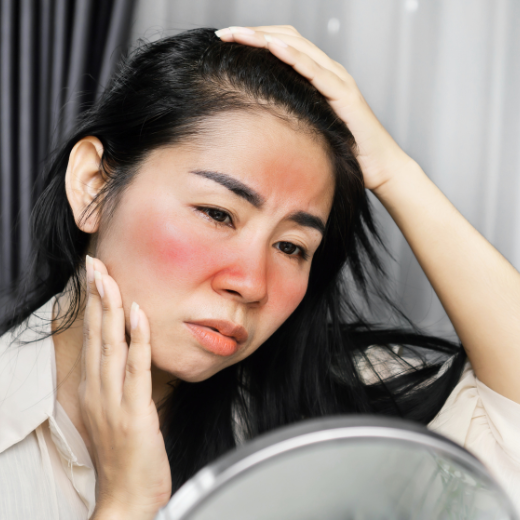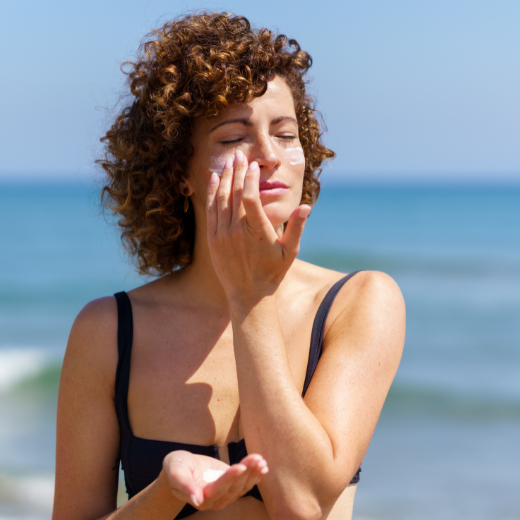Looking Red? Here's How to Treat a Sunburnt Complexion
Posted by Ellie Swain on May 17th 2024
Those warm rays of sun can feel so soothing and inviting – until you find yourself with a painful, red sunburn on your face.
Whether you forgot your sunscreen while spending time outdoors or underestimated the strength of the summer heat, it’s important to know how to treat your sunburned face quickly and efficiently.
Here’s our guide on treating a sore, sunburnt complexion. Good luck!
How to Treat a Sunburnt Face
Cool down
As soon as you notice your sunburnt skin, rinse your face with cold water or take a cool bath or shower. This will help to soothe the burning sensation and reduce any inflammation.
You should also apply a cool compress to your face. To ease any soreness, you can use a clean cloth soaked in cold water or even a bag of frozen peas wrapped in a towel.
Hydrate, Hydrate, Hydrate
Drink plenty of fluids, too. This will help prevent dehydration, which can worsen the symptoms of sunburn. It’s time to get glugging!
Look For the Right Products
Once you’ve washed and cleansed your face, apply a gentle moisturizer. This will help replenish lost moisture and prevent your skin from peeling. We love the Revision D.E.J Face Cream.
This formula works for even the most sensitive skin types, delivering intense nourishment and comfort for sore, red skin. The moisturizer is loaded with calming ingredients to help restore balance back to compromised complexions.
If you have aloe vera or any suitable products containing the ingredient, this is a great way to treat burnt skin. Aloe vera has soothing and anti-inflammatory properties that can help to reduce the pain and redness of a sunburn.
Apply the gel from an aloe vera plant directly to your sunburned skin, or find a product that contains aloe vera online. The Tuel Calm Soothing Moisture Cream contains skin-calming ingredients, including aloe vera, avocado, and shea butter, that work beautifully together to repair, heal, and condition sad, sunburnt skin.

Seek Medical Help
If your skin is excessively sore from the sun, you can also take ibuprofen or another painkiller. This will help reduce pain and swelling.
But remember, if your sunburn is severe, you may need medical attention. Some symptoms of serious sunburn include blistering, shortness of breath, dizziness, or nausea.
How to Prevent Sunburn
Want to avoid sunburn the next time you spend time in the sun? We bet you do. Here are some tips for preventing a sore sunburn.
Wear Sunscreen with SPF 30 or Higher
When it comes to protecting your skin from the harmful effects of the sun, there’s no such thing as being too careful. Wearing sunscreen with an SPF of 30 or higher is one of the best ways to prevent sunburn, as well as skin cancer. The Tuel Daily Defense Mineral Sunscreen Serum SPF 33 is an excellent daily face option.
Don’t forget to protect your lips, too. Use a lip balm or lipstick that contains sunscreen with an SPF of 30 or higher to protect those peckers. Be sure to apply sunscreen more than once, though. Reapply it every few hours.
Even if you’re not spending a lot of time outdoors, it’s important to reapply sunscreen regularly to ensure you’re getting the full benefit of its protective properties.
When applying sunscreen, keep a few things in mind. First, be sure to apply it liberally to all exposed skin. Second, wait at least 15 minutes after applying sunscreen before heading outdoors. This will give the sunscreen time to absorb fully into your skin.
Finally, remember to reapply sunscreen after swimming or sweating. Water and sweat can remove sunscreen from your skin, so it’s important to reapply as soon as possible after you take a dip or hit the gym.
Seek Shade
If you’re planning to spend a lot of time outside, seek shade when you can. Try to stay out of the sun during the peak hours of 10 a.m. to 4 p.m., as this is when the sun is at its strongest and brightest. Cover up with clothing, a hat, and sunglasses when you’re in the sun.
You should also learn the signs of sunburn and what to do if you get one. For example, keep an eye out for red, painful skin that’s warm to the touch. If you have any of these symptoms, get out of the sun and follow the tips above.


